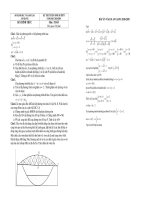Cs224W 2018 63
Bạn đang xem bản rút gọn của tài liệu. Xem và tải ngay bản đầy đủ của tài liệu tại đây (4.68 MB, 11 trang )
CS224W Project Report:
Characterizing and Predicting the Economic Network of
Corporations
Chung Fat Wong ()
code: />
1
Introduction
Corporations are not independent entities, but are linked to each other through many types of
relationships. Examples of these links might be the relationship between a supplier and a customer, in
which case the link is explicit and contractual. On the other hand, two corporations might be classed in
the same industry in which case the link is more subjective. In this paper, we focus on a network model of
corporations based on the former type of relationship. Specifically, the nodes of the network represent
individual firms, and there is a directed edge from one firm to another if the former (supplier) sells goods
to the latter (customer).
Supplier and customer links constitute one aspect of the supply chain network of corporations, and hence
are important to study given that they form the backbone of many industries. Similar to recent studies on
supply network topology, for example [1], we explore this graph using a variety of network analysis
techniques. In addition, we use historical stock price movements of connected nodes as a novel empirical
measure of the usefulness of the theoretical models. For example, we identify structural roles in the
supplier and customer network to determine whether some customers should have an out-sized
influence on the stock price of their supplier firms. We also detect community structures within the
network to identify groups of corporations which should have correlated stock price changes.
The simplest depiction of a supply chain is a linear chain consisting of six nodes, representing each of the
following entities: Raw materials, Supplier, Manufacturer, Distributor, Retailer and Customer (Fig. 1). In
the modern world, this linear chain model is insufficient because two main factors: (i) the complexity
involved in manufacturing today’s products means that each manufacturer could have several suppliers
upstream as well as itself supplying to several nodes downstream and (ii) modern supply chains do not
purely consist of goods flowing from one node to the next, e.g. two corporations might be linked by an
agreement to co-create patents for product design. By focusing on supplier and customer links only, our
supply network model captures most of the complexity of (i), whilst avoiding the added complications of
(ii) since many of these are not easily quantifiable.
Figure 1
2
Related work
Although there is a large body of work on supply chain management, the study of the topology of the
supply chain networks themselves first began around 2000. Since then, researchers have studied the
structure of supply chain networks at various levels, going from the whole-network level down to node
level.
At the whole-network level, the degree distribution of supply chain networks has been widely studied.
For example, in [1], it was shown that the degree distribution of the automotive supply network
confirmed the small world effect. However, this did not show up in the aerospace industry when studied
in [2]. The reason for this difference might be due to the fact that aerospace production is a bespoke and
low volume business, leading to highly specialized suppliers and hence a low degree of clustering within
the network. On the other hand, the automotive industry is standardized and high volume, leading to
common supplier switch-over and multi-sourcing and hence a high degree of clustering within the
network. Currently the degree distribution has not been generalized for supply chain networks of
different industries and this remains an interesting area for future research [3].
At the node level, several authors have
authority and hub centralities, etc to
network. For example, in [4], the Katz
disruption while the authority and hub
used the metrics such as degree centrality, betweenness centrality,
identify firms occupying special positions in the supply chain
centrality was proposed to measure a supplier’s risk of spreading
centralities were applied to measure the risk of a link failure.
For the mesoscale characterization of the supply chain networks, the work has generally focused in the
detection and analysis of communities within the network. For example, the authors in [1] detected
different communities in the Toyota network using a community detection algorithm for directed graphs
[5]. Analysis of the communities showed that their structures differed markedly depending on whether a
particular community produced parts specific to the automotive industry or parts used more widely
across different industries, e.g. electronics. For communities producing electronic parts which are broadly
used, the network structure is decentralized with a high clustering coefficient. The work in [1] is most
similar to the approach that we will take in the paper with respect to the analysis of the supply chain
network.
Finally, in related work [6], although it did not consider the topology of a supply chain network, it did
provide inspiration for us to use historical stock price changes as an empirical measure of the accuracy of
the network models. The authors in [6] showed that the upgrade (downgrade) of a significant customer
will lead to a lagged positive (negative) return in the stock price of the supplier. The delayed response is
posited to be due to the attention constraints of investors to all the different types of links between
corporations. Indeed the authors showed that this effect can lead to market outperformance if embedded
in a trading strategy which goes long (short) the supplier’s stock when the stock of large customer rises
(falls).
3
3.1
Methodolgy
Dataset Collection
The data for this paper is mostly obtained from Bloomberg. Unlike other types of financial data, suppliercustomer data are usually incomplete because corporations have few regulatory obligations to disclose
and are unlikely to do so voluntarily as supplier-customer relationships can be seen as trade secrets. For
example, in the US, the SEC's Regulation S-K states only that corporations must disclose customers that
are greater than 10% of revenues on an annual basis. Since around 2011, Bloomberg started to make
available to its users supply chain data aggregated from Regulation S-K disclosures as well as other
sources, e.g. conference call transcripts, capital markets presentations and company press releases. In
Appendix, we show the current largest customers of Intel Corp sorted by their contribution to Intel Corp's
revenues (e.g. Dell Technologies Inc is the largest customer by revenue contribution at 16%).
For this paper, we only considered corporations (either as supplier or customer) which are included
within the Russell 3000 index. This index is composed of the 3000 largest US listed companies as
determined by market capitalization, approximately 98% of the investable US equity market. We imposed
this constraint as (i) the supply chain data for US firms is more reliable due to regulatory disclosure
requirements and (ii) historical stock price data is only available for listed firms. However, we realize that
this constraint is a trade-off as large private companies such as Dell Technologies Inc will be excluded as
well as companies domiciled outside of the US, e.g. Lenovo Group Ltd. Hence, the top two customers in Fig.
2 Appendix are excluded from our network. One potential avenue for future research is to include
corporations listed outside of the US in the network to reflect the increasingly global nature of supply
chain.
For each firm in the Russell 3000 index, we extract the identities of all of its customers from
Bloomberg database. Then for each customer, we determine whether it is in the Russell 3000 index
exclude it from the network if it is not. Our customer data cover the period between 2013 and 2018.
also extract from Bloomberg the historical stock prices for every supplier and customer within
network for the whole time period on a monthly frequency.
3.2.
the
and
We
our
Algorithms
In the main analysis of this paper, we frame the work as a prediction problem. Specifically, for each pair of
nodes in the network, we are trying to predict the correlation between the returns of their stock prices
using the structure of the network as features.
3.2.1
Shortest Path Distance and Node Centrality
We start with the simpler measures of the network as features. The shortest path distance is the most
intuitive of these as we would expect that companies which are neighbours to have much higher
correlated stock prices than pairs which are several hops away or not connected at all. In economic terms,
this is because when the customer of a firm does well (or badly) then the firm itself will do well (or badly).
There are many measures of centrality for nodes in a network. These are used to rank the importance of
the nodes because we would expect that a large firm such as Walmart Inc, which is central to a large
interconnected network of many suppliers, would move the stock price of those suppliers more than
smaller firms. We choose PageRank [6] to test this as it is one of the measures that has shown impressive
empirical results in other networks.
For any nodej, the PageRank value r;is defined iteratively as: 7; = Yj; BE +(1- B)=
3.2.2
Motif Detection and Motif Spectral Clustering
To look at structures which are high level than single nodes, we use motif detection [7] and clustering [8].
In motif detection, we count the frequency of non-isomorphic direct subgraphs of a certain size in our
network and compare that frequency distribution with a null model. Specifically, we count all 3subgraphs in our network and compare that with the configuration model which generates random
networks with the same degrees sequence as our original network. The configuration model does this by
taking our original network, picking pairs of edges at random and then switching the end points. This
repeated many times, which in our case was around 10,000.
Comparing the frequency of different motif types in our network allows us to find motifs which are overrepresented in our network and hence might be an important aspect of supply networks in general. We
can then cluster the network using those over-represented motifs as targets in the spectral clustering
algorithm [8]. This is an algorithm which constrains clustering based on keeping as many instances of a
particular motif intact as possible within each community. More precisely, given a motif M, the algorithm
aims to find a cluster (defined by a set of nodes S) that minimizes the "Motif Conductance":
cuty(S,S)
a(S) = min[voly(S), voly(S)]
Finding the set S with the minimal motif conductance is NP-hard. However, in [8], the researchers showed
that it is possible to use some of the machinery from spectral clustering to produce a similar algorithm
which will obtain near optimal motif conductance. The algorithm is as follows:
-
-
Step 1: Given a graph G and motif M, form a new motif adjacency matrix Wy whose entries (i, j)
are the co-occurrence counts of nodes i andj in the motif M: (Wy) = number of instances of M
that contain nodes i andj
Step 2: Apply spectral clustering on Wy to compute the spectral ordering z of the nodes
Step 3: Find the prefix set of z with the smallest motif conductance, i-e. if S; = {Z1, ....., Zr}:
S:= arg min, Qy(S;)
Once we have the clusterings, we generate a new feature for each pair ofnodes which is 1
3.2.3
Node2Vec embeddings
Finally node2vec embeddings [9] can also be used as features in our prediction. The algorithm to
generate node2vec embeddings is based on the random walk approach which proposes that, in general,
the dot product of the embeddings of a pair of nodes (u, v) should be close to the probability that u and v
co-occur on a random walk. This leads to the minimization of the objective function, which in practice is
minimised using negative sampling:
_
LEO,
>,
ueV vVENR(u)
exp(zi zy)
eg (as)
The node2vec algorithm also introduces the concept of biased random walks so that the embeddings
could interpolate between BFS and DFS exploration of the network. This is done by adding a return
parameter p and an in-out parameter q. If the current node of the random walk is w and the previous
node was s, then the probability of (i) moving to back to s is 1/p, (ii) moving to any node which is the
same distance from s as w is 1 and (iii) moving to any node which is farther away from s than w is 1/4.
To combine the embeddings from two nodes as a feature, we concatenate or sum the embeddings from
the individual nodes.
3.2.4
Learning Algorithm
Once we have all the features generated above, we train a ridge regression model as a learning algorithm
to predict the correlation of stock returns between two nodes. Concretely, the ground truths vector Y
contains the correlation of returns for all possible node pairs (u, v). The feature array X contains the
features generated from each pair (u, v), e.g. shortest path length between u and v, and sum of
embeddings of u and v, etc. We divide the data into a training set (around 70% of the total data) then use
the remaining data as the test set. Each experiment will consist of training a model on the training set
using only a subset of the features, e.g. PageRank only, and then that model will be evaluated on the test
set. The experiments overall tell us whether using more sophisticated features generated from the
structure of the network leads to better predictions.
Ridge regression addresses some of the problems of ordinary least squares regression by imposing a
penalty on the size of the coefficients. Hence, the penalized residual sum of squares that need to be
minimized becomes:
Miny||Xw — y||Ÿ + allwll?
The score of a ridge regression model is given by the coefficient of determination R? of the prediction. The
best possible score is 1.0 and a constant model (not taking into account any features) would get a score of
0.0.
4
4.1
Results
Summary Statistic of the Network
We build the network using every corporation within the Russell 3000 index as a node. We then create a
directed edge from one firm to another if the former (supplier) sells goods to the latter (customer). This
network has 3007 nodes and 4791 edges. (Despite its name, the Russell 3000 actually has 3007
constituent members.) To visualize part of the network, we show in Appendix the customer subgraph of
Intel Corp. It makes sense that well-known hardware companies such as AAPL and HPE should be large
customers of Intel Corp, and we note once again that Dell Technologies Inc is excluded from the network
as it is not a listed company.
Looking at the network level, Fig. 2 shows that the network exhibits a power-law degree distribution of
node out-degrees, i.e. P(k) = akY for constants a and y. Hence it is scale-free withy = 1.30. Fig. 3 shows
that this is also true when considering node in-degrees, withy = 1.15 in this case.
C0-
1094) xEh >2 a2) 4e
Figure 2: Degree distribution of Node Out-degree (log scales)
rcdoy
ee Distiouton G007 4791) 222 (3073 notes it Prep > awg cog C21 155 (0.0515)alts 22mg cay
Figure 3: Degree distribution of Node In-degree (log scales)
m”......
Fig. 4 shows the average clustering coefficient as a function of node degree. Here we see that the
clustering coefficient decreases with increasing node degree, which again is indicative of a scale-free
network.
tư
ước
Figure 4: Average clustering coeff vs Node degree
We further find that the largest strongly connected component consists of 91 nodes and 294 edges, and
the largest weakly connected component consists of 1178 nodes and 4767 edges. Since the largest weakly
connected component only consists of 40% of the total number of nodes but 99% of the total number of
edges, many of the nodes in the network are not connected to other nodes. We note that this could be due
to the incompleteness of our data, i.e. a supplier-customer relationship might not be captured in the
Bloomberg database if they cannot be found in public sources. We keep this in mind when performing
other analyses of the network, e.g. community detection.
To create the correlation matrix for the stock price returns, we calculated the monthly returns for each
stock over 2013 to 2018. The correlation was then calculated for each of the stock's return time series
against every other stock. This resulted in a 3007 by 3007 correlation matrix.
Correlation of returns of node pairs
500000
400000
300000
200000
100000
06
-04
-02
00
02
04
06
08
10
Figure 5
Figure 5 is a histogram of the correlations over all pairs of nodes.
correlations is well balanced with mean around 0.17%.
It shows
that the distribution of
Node pairs: ShortPath vs Corr of Returns
10
08
°
06
04
02
00
~0.2
-0.6
:
0
r
2
r
4
+
6
œ3
~0.4
Figure 6
Figure 6 is a plot of the distribution of the correlations for different shortest path lengths. It shows (i) for
the smaller path lengths, the range of correlations can be very large so there's no easy solution based on
shortest path length alone and (ii) for longer path lengths, the correlations are more tightly centred
around 0, which is to be expected.
4.2
PageRank
Using PageRank [6] as a measure of the importance of nodes, we find that the five corporations with the
highest PageRanks are:
1)
2)
3)
4)
5)
Walmart Inc
The Boeing Co
Lockheed Martin Corp
Intel Corp
Tech Data Corp
It makes sense that such large and complex organizations should have the highest PageRanks.
As discussed in the methodology section, we then use the PageRanks of a pair of nodes to try and predict
the correlation of stock returns for those nodes. The ridge regression model was trained on the
PageRanks of all the pairs of nodes in the training data as well the shortest path length between each pair.
Using the model on the test data, we found the R2 was 0.00023. Hence the model does not perform better
than a constant model.
4.3.
Motifs
We next examine the network using motif detection [7] and compare the frequency of non-isomorphic
directed 3-subgraphs in our network with a null model. In this case, the null model is created using the
configuration model which generates random networks with the same degree sequence as our original
network. Fig. 7 shows the z-scores obtained from our network for each motif type.
Russell: z-scores vs motif type
60
40
zscore
20
[
bya
40 ————
0 1 2
3
4
5
6
——
7 8 9
1011 12
r
Figure 7
The spike represents a motif where two suppliers selling to one manufacturer (i.e. two nodes both
pointing to a third node with no other edges) so it makes sense that our network would have
overabundance of this motif versus a random network.
Hence it made sense to target similar motifs using the motif-based spectral clustering algorithm. We
performed motif-based spectral clustering on the network using M5, M6, M8, M9, M10 (where M10 is the
over-represented one).
Sweep profile plots for different motifs
=
a
144
Motif conductance
1.23
Figure 8
Fiedler vector plots
0.1
0.0
_
_
-0.1
~0.2
~0.3
cdge
==
MS
M8
M6
M
==
M10
-0.4
0
20
40
60
80
100
Figure9
M1
M2
M3
M4
M5
M6
Mr
.ô
.ô
`,
Q
`,
e
M8
M9
4,
M10
/,
M11
...e.
...đ
`
e
oe
,`,
...eô
e+
Of"
M12_
M13
a
e
=
o
`
'`
h
/'`
es
e
a
e
+e
Figure 10
Plotting
than the
each of
between
network
the sweep profile for each motif in Figure 8 showed that M10 does not cluster the network better
other motifs its over-representation. This can also be seen in the plot of the Fiedler vectors for
the motif solutions in Figure 9. Only the Fiedler vector for M6 has well distinguished plateaus
the elements of the Fiedler vector. But unfortunately the M6 motif is not well represented in the
hence conductance is not well minimized when targeting this motif.
Using the ridge regression test, we find that again the model does not perform well. In fact, adding the
motif-clustering feature to PageRank slightly decreases R2 score to 0.00021.
4.4
Node2vec
Node2vec embeddings were generated from the network using different sets of hyperparameters, e.g. (p,
q) = (1, 5), (1, 1), (5, 1), embedding dimensions = 64, 128, etc. To check the embeddings qualitatively, we
used k-means clustering algorithm to separate the nodes into 10 clusters. The network was then drawn
with those clusters in place. The node2vec clusterings did a good job of identifying the communities of
dense edges as shown in the plot.
Figure 11: Clustering of supply network using node2vec: p1, q1
Node2vec also showed better performance than the other methods of generating features when used to
train the ridge regression model.
p
q
1
1
5
1
1
1
5
1
1
1
Embedding
dimension
128
128
128
64
128
Walk length
R2
80
80
80
80
160
0.565194
0.520322
0.552524
0.564501
0.521488
Itis not clear why the node2vec embeddings do much better than the other types of features, one possible
reason is due to the larger number of variables. Changes in the hyperparameters do not make a large
difference to the performance.
5
Conclusions
We generated a range of features from the network to train a regression model for predicting the
correlation of stock price returns between firms in the supply network. These included PageRank, Motif
clusters and Node2Vec. Features from PageRank and Motif clusters do not have much predictive power at
all. Node2vec performs significantly better and further work can be done to investigate the source of the
outperformance. In addition, it would be interesting to investigate whether node2vec can be used to
predict other features of the supply network, e.g. evolution of new supplier-customer relationships.
6
References
[1] Kito, T., Brintrup, A., New, S., and Reed-Tsochas, F., The Structure of the Toyota Supply Network: An
Empirical Analysis (Sa€id Business School, WP, 2014), p. 3.
[2] Brintrup, A., Barros, J., and Tiwari, A., “The nested structure of emergent supply networks,” IEEE Syst. J.
PP, 1 (2015).
[3] Brintrup, A., Ledwoch, A., "Supply network science: Emergence
field"
of a new perspective on a
classical
[4] Ledwoch, A., Brintrup, A., Mehnen, J., and Tiwari, A., “Systemic risk assessment in complex supply
networks,” IEEE Syst. J. PP, 1 (2016).
[5] Leicht, E. A. and Newman, M. E., “Community structure in directed networks,” Phys. Rev. Lett. 100(11),
118703 (2008).
[6] Page, Lawrence and Brin, Sergey and Motwani, Rajeev and Winograd, Terry (1999) The PageRank
Citation Ranking: Bringing Order to the Web
[7] Milo, R., et al, Network Motifs: Simple Building Blocks of Complex Networks
[8] Austin R. Benson, David F. Gleich, and Jure Leskovec., Higher-order Organization of Complex Networks.
[9] Grover et al, node2vec: Scalable Feature Learning for Networks. KDD. (2016)
7
Appendix
$2ea
INTEL CORP Equity
INTC
US
$
| SPLC -] Related Functions Menu |
c
07
Ác:
ee
]
29.913.193
Peers +
Actions
47.63E
x
Output
x
48.72
48.75
/48.730
36
47.59E
x523
Supply
_
7)
Chart
8)
1.45B
Chain Analysis
Table
12 Fields
of
Name
Country
Market
94)
Cap
%Revenue
Sales Relations.. Account As
Surprise
Value Type
(Q)
Customer subgraph of Intel Corp
H
6 Filters
%C.. Source









